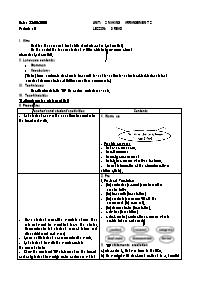Giáo án môn Tiếng Anh Lớp 8 - Unit 2: Making arrangements - Period 10, Lesson 3: Read

I. Aim:
Reading the paragraph for details about Alexander Graham Bell.
By the end of the lesson, students will be able to know more about
Alexander Graham Bell.
II. Language contents:
• Grammar:
• Vocabulary:
(To be) born, emigrate, deaf, mute, transmit, invent, invention, inventor, lead-led-led, assistant, conduct, demonstrate, exhibition, countless, commercial.
III. Techniques:
Reading for details, T/F, Qs and As, ordering events.
IV. Teaching aids:
Bạn đang xem tài liệu "Giáo án môn Tiếng Anh Lớp 8 - Unit 2: Making arrangements - Period 10, Lesson 3: Read", để tải tài liệu gốc về máy bạn click vào nút DOWNLOAD ở trên
Date: 25/09/2006 UNIT: 2 MAKING ARRANGEMENTS Period: 10 LESSON: 3 READ I. Aim: Reading the paragraph for details about Alexander Graham Bell. By the end of the lesson, students will be able to know more about Alexander Graham Bell. II. Language contents: Grammar: Vocabulary: (To be) born, emigrate, deaf, mute, transmit, invent, invention, inventor, lead-led-led, assistant, conduct, demonstrate, exhibition, countless, commercial. III. Techniques: Reading for details, T/F, Qs and As, ordering events. IV. Teaching aids: Text book, poster, pictures of Bell V. Procedure: Teacher’s and student’s activities Contents - Let students answer the questions by coming to the board and write. 1. Warm up - Possible answers: - to have a message. - to call someone - to make arrangements - to talk to a person who lives far from. - to get information at the airport or railway station quickly. - Have students repeat the words in chorus then rub out word by word but leave the circles. Remember to let students repeat before and after rubbing out each word. - Go on until students can remember the words. - Get students to write the words again in the correct circles - Show the poster of T/F statements on the board and ask students to work in pairs and guess which statements are true and which are false. - Give feedback. - Ask students to read the text on page 21-22 and check their prediction. - Have students correct false statements. 2. Pre I. Pre-teach Vocabulary - (to) emigrate: (example): go to another country to live. - (to) transmit: (translation) - (to) conduct: (synonym: What’s the synonym of (to) carry out). - (to) demonstrate: (translation). - a device: (translation) - a deaf- mute: (explanation: a person who is unable to hear and speak) II. T/F statements prediction a) Alexander G. Bell was born in the USA. b) He worked with deaf-mute patients in a. hospital in Boston. c) Thomas Watson was Bell's assistant. d) Bell and Watson introduced the telephone in 1877. e) Bell experimented with ways of transmitting speech between deaf-mutes over a long distance. f) Bell demonstrated his invention at a lot of exhibitions. - Ask students to look at the book page 22. - Get students to read the events of Bell's life and put them in the correct order. - Ask them to compare with their partners. 3. While a) Alexander G. Bell was born in the USA. I—11—I b) He worked with deaf-mute patients in a hospital in Boston. I—11—I c) Thomas Watson was Bell's assistant. I—11—I d) Bell and Watson introduced the telephone in 1877. I—11—I e) Bell experimented with ways of transmitting speech Between deaf-mutes over a long distance. 1—11—I f) Bell demonstrated his invention at a lot of exhibitions. - Alexander Graham Bell 1. was born in Scotland 2. went to live in Canada. 3. Went to live in the United States. 4. worked with people who could neither speak nor hear. 5. worked with Thomas Watson. 6. Successfully demonstrated his invention. 7. Invented the telephone. Writing it up: - Get students to write a paragraph about Bell's life, using the information from the text. - Let them swap their writings and correct. 4. Post - Suggestion: Alexander Graham Bell was born on March 3rd, 1847 in Scotland. He went to live in Canada and then to the U.S.A in 1870s. He worked with deaf mutes at Boston University and did experiments with ways of transmitting speech over a long distance. In 1876, he and his assistant - Thomas Watson introduced the telephone successfully and in 1877 the first telephone was in commercial use. - Ask students to write the paragraph (they have just written and corrected with their friends) into their notebooks. 5. Homework COMMENTS:
Tài liệu đính kèm:
 giao_an_mon_tieng_anh_lop_8_unit_2_making_arrangements_perio.doc
giao_an_mon_tieng_anh_lop_8_unit_2_making_arrangements_perio.doc





